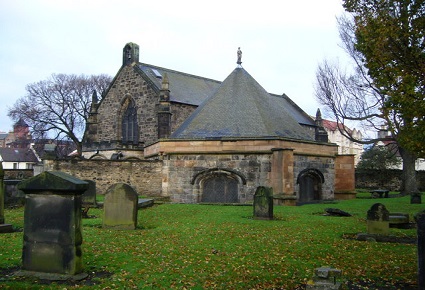St. Triduana was a Scottish saint whose life is connected to the translation of the bones of St. Andrew to Scotland. According to the 16th century Aberdeen Breviary, Triduana was a Greek woman who came to Scotland sometime in the 4th century. Most accounts say that she came as a consecrated virgin in the entourage of St. Regulus, the famous Greek bishop who brought the bones of St. Andrew the Apostle to Scotland. The details of her life in Scotland are uncertain and bound up with Scottish lore; most traditions relate that she became the victim of the unwanted advances of a Pictish king and gouged out her own eyes rather than break her vow of virginity. She seems to have taken up residence at Restalrig, near Edinburgh, where she healed the blind who came to her. Though tradition assigns her to the time of St, Regulus, every other aspect of her life suggests a much later date, perhaps in the early 8th century, as other tales have her as a contemporary of St. Boniface.
The story of the virgin who plucks her eyes out is common; the story of St. Triduana bears a striking resemblance to the Irish story of St. Deirbhle, and both seem to draw on the earlier hagiography of St. Lucy, who also was supposed to have plucked out her eyes. The story of St. Triduana may have been inferred from the saint’s later reputation as a healer of the blind, for which she is primarily remembered.
In the 12th century, the Norse Earl of Orkney Harald Maddadsson punished bishop John of Caithness by having him blinded. According to the 13th-century Orkneyinga Saga, John prayed to “Trøllhaena”, and later regained his sight when brought to her “resting place”, possibly referring to a local northern shrine rather than Restalrig. A 17th century Acta Sanctorum records an Englishwoman being cured of blindness after being instructed to visit the shrine of Restalrig in a dream by Triduana herself. A shrine to Triduana still exists in Restalrig (pictured above, now a suburb of Edinburgh) dating from the 1400s. The lower levels of the shrine frequently flooded, leading the faithful to erroneously conclude that the shrine was a well, and it is still inaccurately described as “Triduana’s Well.” Another well in Orkney is also associated with Triduana and has been the site of miraculous cures.
The devotion of the people to St. Triduana was very strong and it was only with great difficulty that the Protestant Reformers of Knox’s Kirk could undo it. The 19th century Presbyterian Minister of Westray John Armit wrote:
“Such was the veneration entertained by the inhabitants for this ancient saint, that it was with difficulty that the first Presbyterian minister of the parish could restrain them, of a Sunday morning, from paying their devotions at this ruin, previous to their attendance on public worship in the reformed church. Wonders, in the way of cure of bodily disease, are said to have been wrought by this saint, whose fame is now passed away and name almost forgotten.”
St. Triduana’s feast is celebrated on October 8th. She is invoked against blindness and diseases of the eyes.

Phillip Campbell, “Triduana of Scotland,” Unam Sanctam Catholicam, May 24, 2013. Available online at https://unamsanctamcatholicam.com/2023/04/st-triduana-of-scotland

